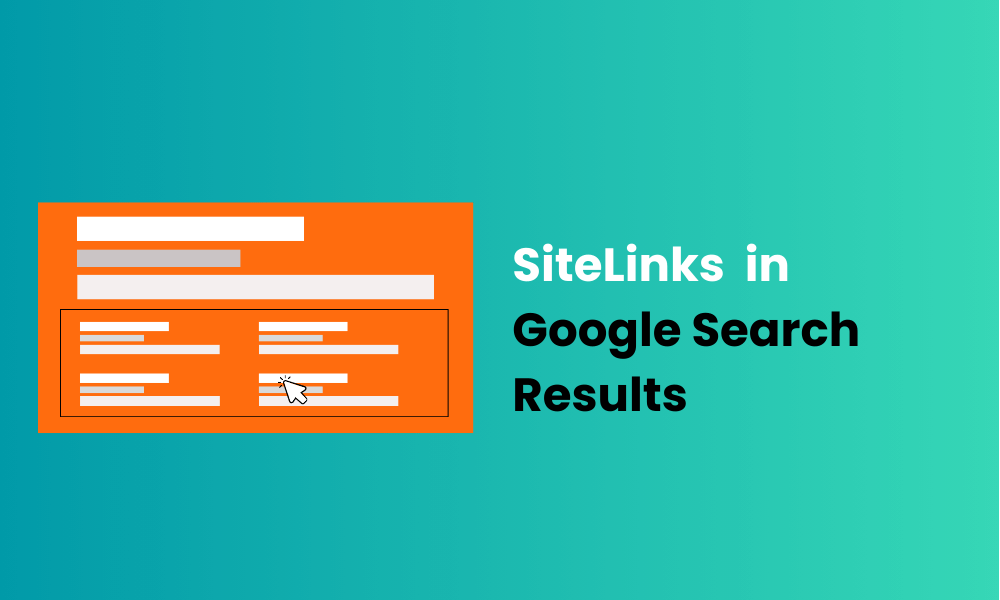
How to Get Sitelinks in Google Search Results
Table of Contents
What Are Google Search Sitelinks?
Google Sitelinks are internal links to a site that appear below the main site URL, in search results. The main purpose of sitelinks is to improve user experience and drive traffic to specific website sections. See the image below.
As you can see, this is the first search result that appears on the search engine results pages (SERPs) when you key in SEMrush.

Sitelinks are not displayed for all websites. They are shown only when they are useful to the searcher, and they are automated by Google algorithms.
These internal links to the website are presented with a brief description. In the example shown above, Keyword Magic Tool, Plans & Pricing, Site Audit, Get Semrush Free Trial, Blog, and Position Tracking are the internal links.
You can find sitelinks when you perform a brand search, and they help you to navigate around the website quickly, based on your search requirements. Most often, you can see two, four, or six internal sitelinks under the first search result.
Why Are Sitelinks in Google Search Results Important?
1. Sitelinks Increase Your Click-Through Rates (CTR)
Sitelinks make your website’s listing on the search page appear twice as large as your competitors’ listings. When your business website is displayed twice as large leading to better click through rates (CTR).
The average click-through rate for the 1st position in Google SERP is 28.5%. The comparable figures for the 2nd and 3rd positions are 15.7% and 11% respectively. Beyond this, the click-through percentage falls rapidly.
At the time of this writing, Sitelinks are usually shown for the 1st position on Page 1 of the Google SERP. That, however, may change in the near future.
The click behaviour of Google searchers heavily favours websites that are ranked in the top position. While all websites ranked in the 1st position may not have Sitelinks, the ones that have Sitelinks are guaranteed an improved click-through rate.
2. Sitelinks Give Greater Exposure to Your Brand’s Category Pages, Not Just the Homepage
Sitelinks typically link out to the most important category pages on your brand’s website.
This makes them an effective way to inform searchers about your products and improve your brand awareness.
For instance, when you type in Stella McCartney UK on your search bar, you see links to her brand’s top selections:

In the example above, is the shopper going to click on the About Stella page or the Unisex Ready to Wear page, or are they more likely to visit the Dresses or Women Collections page?
This would obviously depend on what the searcher is looking to purchase, but having direct access to additional links in search results given greater exposure to your Brand.
3. Sitelinks Signal Brand Trustworthiness to Your Potential Customers
Many marketers would like to tell you that content is king. The truth is Trust is king.
Sitelinks give a better idea of product categories in your store. Hence, Sitelinks can be a useful ecommerce metric to determine the trustworthiness of a brand.
When a shopper sees Sitelinks on a store, it’s a sign that Google trusts that business enough to present them with Sitelinks. Imagine a shopper searches for a not-so-popular brand with comparatively low trust ratings. Chances are they may not see Sitelinks for this less popular brand.
But how about a brand that’s popular? Chances are that a shopper will see Sitelinks. Let’s look at another popular brand:

Google is committed to giving shoppers the best possible experience. So it would do its best to promote only trustworthy links above the fold.
Are All Webites Eligibile For SiteLinks?
Sitelinks are not displayed for all websites.
In their official Sitelinks documentation, Google mentions that they only show such links for websites that their algorithms assess as useful for searchers.
What makes a site useful you might think?
First, the site should have a clean structure. This allows Google’s algorithm to find good links and show them as sitelinks in SERP results.
Next, your site should be authoritative and relevant to the user’s query to qualify for sitelinks.
How to Create Google Sitelinks for Your Website?
When you click on the homepage of Disney Plus UK, you’ll see the exclusive series, top hit movies, and new originals on offer there (please see the image below).
The reason is these are the shows that viewers love, look for, and watch the most. Therefore, these shows will inevitably get the preferred slot on the homepage.
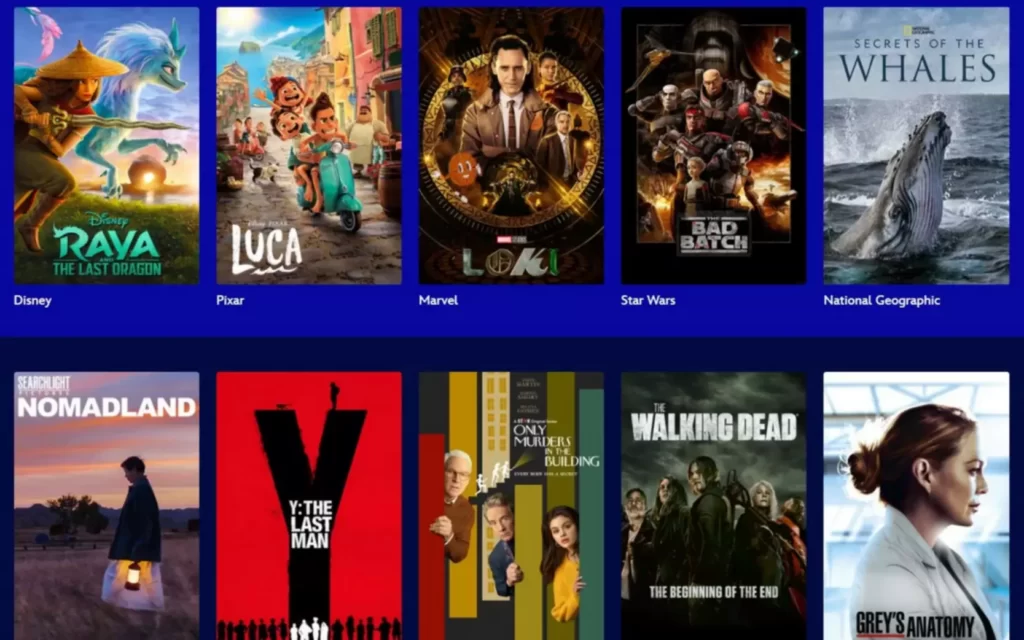
This is precisely how Google Sitelinks work for your ecommerce site. Google will display Sitelinks that shoppers find most valuable.
Google introduced new and improved Sitelinks on 16th August 2011. You can see how Sitelinks looked before and after the changes on this page.
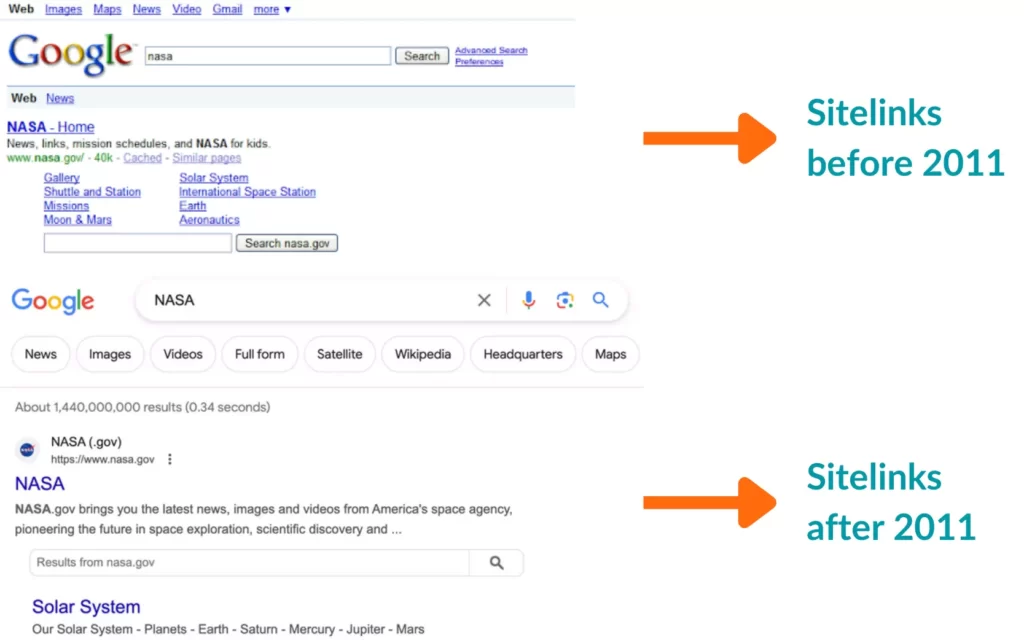
Discussed below are the 6 most relevant recommendations on how to create Google Sitelinks for your website.
1. Relevant Meta Data
You can use page-level meta tags to provide information about each web page on your store to search algorithms.
Your chances of acquiring Google Sitelinks improve considerably when your on-site SEO is close to perfect. You’ll need to ensure your content is useful to the shopper so that Google spiders understand you have earned all the clicks and impressions from the shoppers. The search spiders will then determine that if your web pages deserve those sitelinks.
You need to focus on the titles and H1 tags in your store. The page title, heading, and subheadings are all vital to achieving perfect on-site SEO. The description of your content needs to be clear, the main keywords need to be included, and shoppers should also be able to scan your content fast.
2. Logical Site Structure
Take a meticulous look at your website structure.
Is the website navigation easy and simple? This is crucial not only for shoppers but also for search engine algorithms. Remember, Google can create your website’s search engine index only by using your site’s navigation.
Additionally, use the Breadcrumbs structure for your website navigation. A breadcrumb (also known as breadcrumb trail) is a sort of secondary navigation system that reveals the shopper’s location in your store.
This term comes from the fairy tale Hansel and Gretel, in which two young children drop breadcrumbs that form a trail, helping them find their way back to their home.
For instance, the navigation for this blog post is:
Homepage > Blog > How to Get Sitelinks in Google Search Results
In WordPress, it’s easy to generate your site’s breadcrumbs. You only need to install the Breadcrumb NavXT plugin or any other similar plugins.
3. Internal Linking
Internal links allow for connections between different pages on your site and signal thematically similar pages to algorithms.
For example, when you repeatedly link to a specific category page from blog articles, Google spiders might consider that as an indication for judging that page’s importance.
Hence, internal linking is one of the most effective ways to indicate to Google spiders to pick the most preferred pages to be used as sitelinks.
Additionally, internal linking is a powerful SEO strategy as it delivers a better user experience, which creates several added advantages. When creating internal links, follow these simple rules:
- Use appropriate anchor text
- Build the highest number of internal links to the pages on your store that you want to be shown as sitelinks.
In Google Search Console, you can generate the internal links report to get an accurate picture of the number of internal links on each page of your website.
4. Avoid Repetition in Your Content
We’ve already seen that the basic rule to get Sitelinks is to remain in the 1st position in the SERP.
Therefore, it’s relevant to emphasise that any issues related to duplicate, thin, and poor quality content can result in a rapid drop in search engine rankings.
5. Add Structured Data Markup
Structured data is a kind of code that helps search engine spiders understand and classify content present on a web page. Structure data typically resides in a fixed field inside a file.
Examples include local business listings that show opening hours, contact information and more and question and answer boxes that appear beneath the search listing.
Let’s consider Rich Snippets (also labelled Rich Results).
As you can see in the image above, Rich Snippets are ordinary Google search results that display additional data.
This extra data is typically pulled from Structured Data located in a page’s HTML. Some common types of Rich Snippets include recipes, events, and reviews.
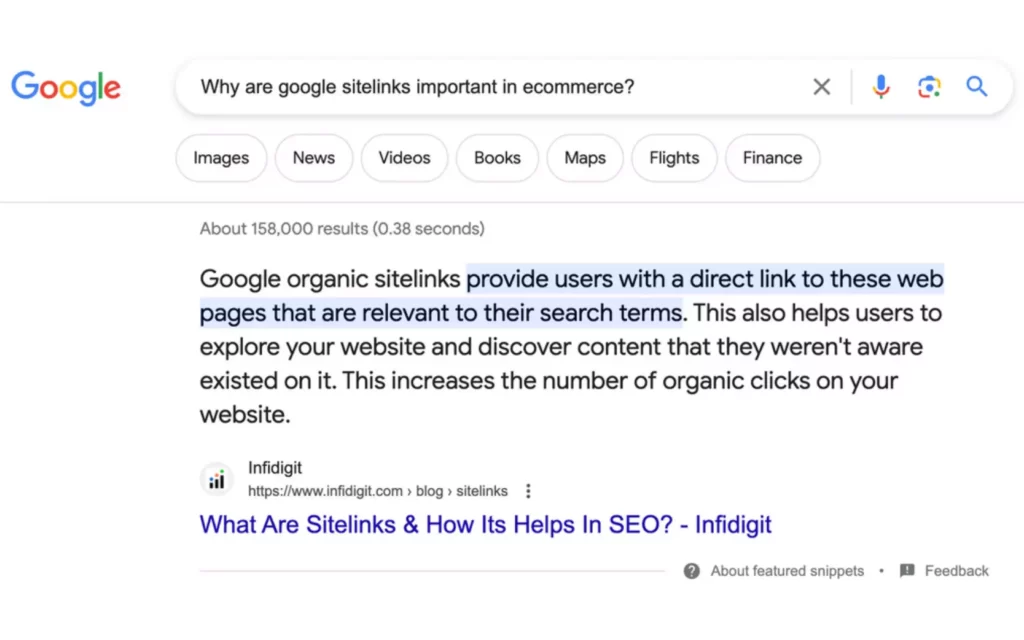
As you can see in the image above, Rich Snippets are ordinary Google search results that display additional data. This extra data is typically pulled from Structured Data located in a page’s HTML. Some common types of Rich Snippets include recipes, events, and reviews.
6. Increase Brand Awareness
Sitelinks will be shown when searchers are performing brand related searches.
Hence, increasing your brand awareness is crucial. You want to make sure that people are aware of your brand and it stays top of mind when they’re searching for your products.
There are a lot of ways how you can increase your brand awareness. Here are some:
- Guest blogging
- Online community participation
- Interviews
- Social media
- Getting positive reviews online
In conclusion, raising brand awareness contributes to positive user engagement, credibility, and trust. This in turn increases the chances of earning sitelinks in Google search.
How to Add Google Sitelinks Search Box Within Search Results?
For some websites, Google will show an additional element in the search results.
This Sitelinks search box allows searchers to do a secondary search only for results on the site of a specific brand.
In the image below, you can see the Sitelinks search box for the target.com website.
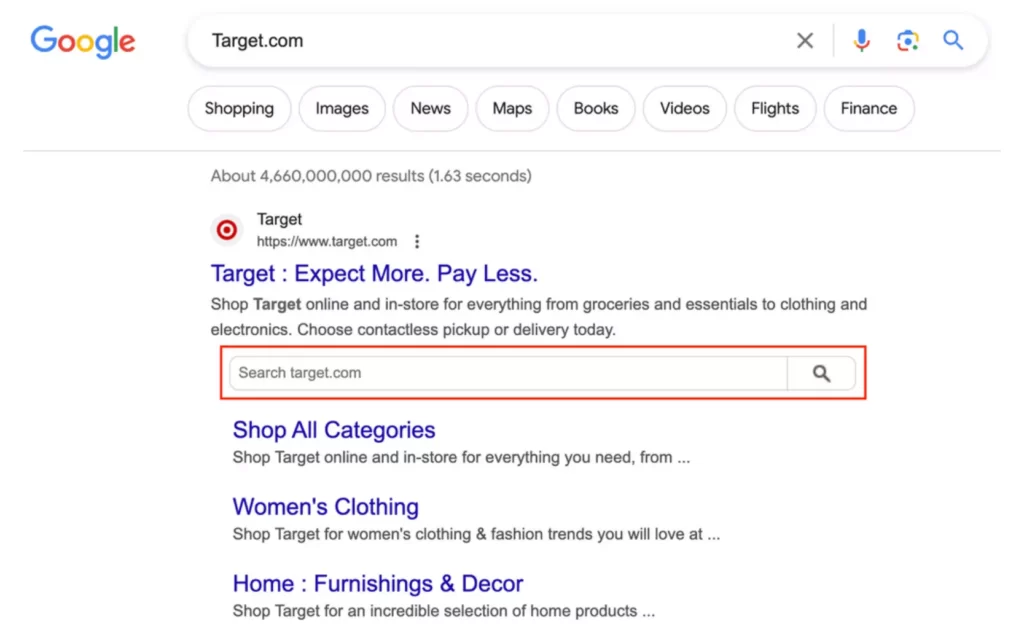
All sites don’t show this search box. It’s linked to both searcher intent and site quality.
Note: On Oct 21st, 2024, Google announced that they will be removing the Sitelinks search box feature from search results due to a drop in its usage. This is a global change, and will apply across all search results, in different languages and countries.
This change does not impact other sitelink elements that appear in search or related rankings. If you have previously added sitelinks search box structured data to your website, you can let it stay. Any unsupported structured data won’t trigger errors or cause issues in search.
Is It Possible to Change Sitelinks in Google Search?
No, it’s not possible to manually control the pages you want Google to display.
Previously, the Demote Sitelinks were available in Google Search Console settings. But this was discontinued in October 2016.
If you don’t want a page to appear in Sitelinks, you’ll need to remove it altogether from Google search by adding the “noindex” meta tag.
In Summary
The first essential SEO step is getting the rankings of your website up. Showing up in search results with Google Sitelinks is simply a solid follow-up.
Once your website is at the number one position of a SERP, look to expand your current real estate.
If you are successful in eliminating your competitors’ results from above the fold, you can swiftly increase your click-through rates (CTR) and conversions. And although it’s not possible to actively change Sitelinks, you can do your best to influence them.

